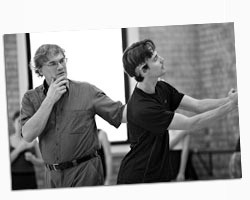Teaching Methodology François Klaus

You would think there’d be no secret to training a ballet company. The rules of classical ballet are very well defined; set curriculums and systems of progression in teaching exists in all the major ballet schools of thought. There is also a significant amount of literature left by influential ballet teachers giving numerous examples of step combinations. Furthermore, any teacher or ballet master is sure to have been a dancer at some point of with an enormous amount of experience in ballet classes. Yet I know that professional ballet training across the world ranges equally from training that truly develops the dancers’ craft to training that merely “warms up”, or even training that is frankly so bad that its only asset is to teach you what not to do.
Throughout my life as a dancer I was exposed to many different approaches to teaching. In my early training I was exposed to the French School with a strong influence from Rudolf Nureyv (who was working with Marika Besabresova at the time) and Erik Bruhn who introduced me to Bournonville.
Later on in Stuttgart I was exposed to the systems of the Royal Ballet School (John Cranko liked the clear lines and intricate footwork of the English) and at Hamburg Ballet there was a strong Balanchine influence under Truman Finney. Finally, Irena Jacobsen reintroduced me to the Kirov school of thought in my later dancing years.
I worked under these different methods for years at a time. Eventually I was able to determine how the different approaches developed different strengths (as well as weaknesses in some domains). This is an understanding that took time to develop however; as a dancer it is easy to tell whether a class feels ‘good’ or not but it can be difficult to distinguish between step combinations that encourage real progress and combinations that are merely fun or even just fashionable (some popular combinations really aren’t very good but become such a staple they are practiced everywhere).
As dancers start to teach, they tend to cater to dancers of their own body type and temperament, forgetting to take the vast array of different body types and abilities of a full company into account. For example, dancers who were very fast and naturally agile have the tendency to give class a little too fast. Similarly, a teacher with choreographic aspirations may create complicated combinations in class for his own fulfillment rather than for the development of his dancers.
With this in mind, good teaching fundamentally requires an understanding of classical ballet on many levels that may not be immediately apparent to the dancer. The most fundamental of these in my opinion is an awareness of how to structure sequences with musical sensitivity. For example, many teachers miscalculate the time it takes to do difficult steps cleanly leading to a mismatch with the music. This means that if the dancer executes one step of the combination well, it makes him late for the next one. The result is that the dancers either fight to be on the music and sacrifice the cleanliness of the exercise or ignore the music in order to do the steps properly.
While it is true that the optimum speed of any step varies with every dancer’s body type and temperament, at the same time most steps, in particular jumps and turns, have a “natural tempo” of execution that should be respected. Of course it can be brilliant to watch a step combination taken out of its comfort zone but in my view this is more of choreographic interest and should remain an exception in class. In training, excessively fast or excessively slow tempos that go beyond the dancers’ control encourage faults.
In a healthy step combination on the other hand, the timing and relationship of steps to one another encourages the dancer to do the steps correctly. This requires a thorough understanding of the required body mechanics as well as an understanding of how one step transitions into another; the execution of any step will vary according to its preceding and the following steps. Finally, the combination must be phrased with musical sensitivity.
There is yet another level of understanding which has to do with reaction and opposition to movement. To use a simple example, if the dancer pushes and opens his arm to the right, his body will automatically push to the left a bit. A similar effect will take place if he closes his left arm towards him; his body will automatically push to the left. The timing of these actions will greatly affect the dancers’ ability to turn and pirouette. Some dancers grasp this principle instantly through natural coordination. However, even though they may be able to demonstrate with surety, an excellent dancer whose technical achievements are primarily reliant on instinct and natural coordination will find these body mechanics difficult to teach and explain.
Finally, there are some other factors to consider. You have to develop an understanding of choreographic complexity, the use and limits of repetition and an ability to balance the composition of the class with a natural evolution of exercises (a brilliant combination at the wrong part of the day can be disastrous.) But the biggest secret is probably this; there are some pieces of advice that are fundamentally applicable to all dancers, and others that are deeply personal to you. Dancers react differently to different approaches, according to physical type and temperament. So be able to distinguish between the universal and the individual, and share your personal gems pragmatically.